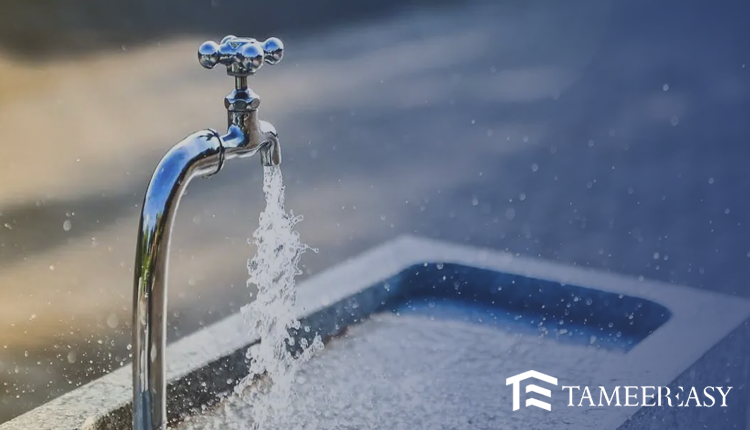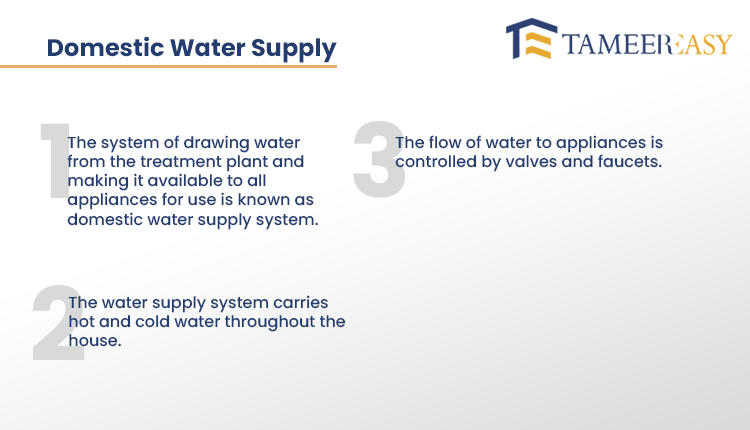Are you facing water low-pressure issues in your kitchen and washroom? Or are you getting severe cold water in winter and extremely hot in summer? If Yes, have you ever thought about the reason behind these water-related issues? Let us tell you that the primary reason behind all such issues is the poor management of the domestic water supply system. There are a bit technicalities involved in this whole water system that are often ignored by the builders, ultimately resulting in multiple issues for the house owners.
Visit TameerEasy Store to Purchase Quality Construction Items
Henceforth, we have taken some time to guide you through the whole procedure. So that you can take extra care while designing the water supply system of your house. In order to get all the information related to the domestic water supply system, we recommend you scroll down the page and get all the relevant information.

What is Domestic Water Supply System?
The whole system of the water through which it is brought from the main water line and supplied to different points like the kitchen, washroom and other places using different paths is called a domestic water supply system.
The water system has four key components which are as follows:
- Water Source: The point from where we fetch the water to our houses.
- Underground Water Tank: The point where we store the water.
- Pumps Room & Transmission Lines: Network of pipes through which water is supplied to different points.
- Overhead Tank: The point where water is stored to be supplied to all the points in the house.
Key Point: The ideal time for making the water system is when you are constructing house walls. Therefore start piping at that time so that any inconvenience of tampering with the walls can be avoided.
Let’s discuss all the important components of domestic water supply one by one and their construction processes.
Underground Water Tank
Underground water tank is the first component in the water system and it should be constructed in a way that it fetches the water through the main source using gravity. To avoid overflow, you should use a flow control valve which will stop the water flow after a certain limit.
Benefits of Underground Tank
- It saves electricity as you will always have sufficient water available in it.
- Water will remain protected from extreme weather conditions like summer and winter. The reason is that sunlight does not fall directly here.
- Water remains safe from microbiological, like bacteria and other microscopic organisms.
Overhead Tank
The overhead tank is constructed on the roof which is connected to the underground tank using pipes. Water is pulled using a powerful electricity-backed pump to the overhead tank from where it is supplied to all places like the kitchen and washrooms.
Few Points to Keep in Mind While Constructing Overhead Tank
- Instead of using plastic or concrete water tank, use fibre glass which will protect the water from the severity of weather and bacterial issues.
- Try to place the overhead tank in a place where there is no kitchen or washroom exactly underneath it.
- The overhead tank should be placed on a side where it can get the maximum momentum by gravity.
Water System Without an Overhead Tank
Additionally, there is another system in which a boaster pump is attached to the outside wall of the underground tank. This pump takes the water from the tank to all the points efficiently with good pressure. This system is called boaster setup and it is thought to be highly effective in domestic water supply systems.


Pipes or Transmission Lines
- These are the lines which take the water from the underground tank to the overhead tank and from their supply water to desired points.
- It is important to keep all these lines exposed before installing them. Some people hide them under the walls for aesthetics which often causes seepage ultimately affecting the finishing of the walls.
- Try to use Copper PPRC, High-Pressure UPVC, or CPVC as they all are highly resistant to extreme weather.
- Afterwards, you can also insulate the exposed material so that they do not remain vulnerable to weather effects.
- If you think that these exposed lines do not look good, you can use a drywall partition or a separate riser through which lines can pass.
Final Thoughts
To sum up the whole discussion, we can say that the domestic water supply system has immense importance for your house. If you take effective measures during the construction, it will save you from multiple upcoming problems. We are hopeful that up till now you have got enough information about the water system. If you still believe you have some confusion or other questions, you can contact us through our website tameereasy.com.







